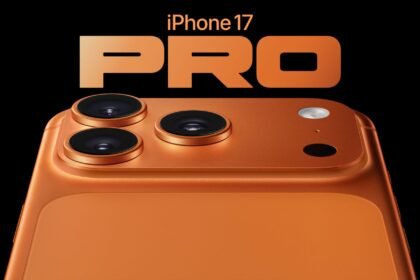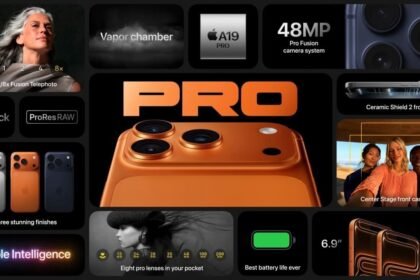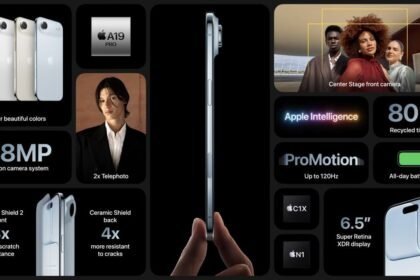I’m planning my upgrade this year, and while the iPhone 17 Pro lineup has plenty of impressive features, there’s one detail that’s hard to ignore — the battery differences between the U.S. and UK models. Honestly, it’s frustrating.
In the U.S., Apple finally made the jump to eSIM-only across all iPhone 17 models. That move freed up space inside the chassis, allowing Apple to squeeze in a slightly larger battery. The result? More endurance, especially on the Pro Max. This year, Apple didn’t just quietly make the change — they actually announced it.
But here in the UK (and across most of Europe), things are different. The Pro and Pro Max still come with a physical SIM tray, and that tray eats into valuable internal space. The trade-off? About 1–2 hours less battery life compared to the U.S. models. And yet we’re expected to pay the same price, and somehow Apple thinks it’s fine.
The Numbers Don’t Lie
Apple likes to talk about fairness, sustainability, and consistency. But with the iPhone 17 Pro lineup, it’s created a two-tier system, and this is straight from Apple’s own spec sheets:
- iPhone 17 Pro Max (U.S.) → Up to 39 hours video playback
- iPhone 17 Pro Max (UK) → Up to 37 hours video playback
| Model | U.S. Battery Life (Video Playback) | U.K. Battery Life (Video Playback) | Difference |
|---|---|---|---|
| iPhone 17 Air | 27 hrs (22 hrs streamed) | 27 hrs (22 hrs streamed) | None (eSIM-only worldwide) |
| iPhone 17 Pro | 33 hrs (30 hrs streamed) | 31 hrs (28 hrs streamed) | ~2 hrs less in the UK |
| iPhone 17 Pro Max | 39 hrs (35 hrs streamed) | 37 hrs (33 hrs streamed) | ~2 hrs less in UK |
| iPhone 17 Air + MagSafe Battery | 40 hrs (35 hrs streamed) | 40 hrs (35 hrs streamed) | None |
That’s a full two hours shaved off just because of regional design choices. Same price. Same hardware. Same branding. But in practice, you’re walking away with a smaller battery configuration simply because it’s not from the U.S and a few other countries, which are Bahrain, Canada, Guam, Japan, Kuwait, Mexico, Oman, Qatar, Saudi Arabia, and the United Arab Emirates.
Two hours may not sound huge, but when you’re spending £1,099+, it matters, especially if you’re on a trip, stuck on a long train ride, in back-to-back meetings, at a festival, or simply away from home with no place to charge. Those extra hours could be the difference between making it through the day or scrambling for a charger.
That’s why battery life is one of the top reasons people upgrade, and Apple knows it. Shrugging it off as a “minor” difference ignores the fact that UK customers are effectively being sold a slightly inferior product.
The iPhone Air Proves Apple Can Do Better
What makes this even more frustrating, inconsistent, and unacceptable is the iPhone 17 Air. It’s eSIM-only worldwide — yes, even here in the UK — and it doesn’t suffer the same battery penalty. That’s proof Apple can sell eSIM-only models across all regions when it wants to.
It makes no sense that the supposedly premium Pro and Pro Max models are the ones stuck with smaller batteries, while the Air quietly gets global eSIM and no battery compromise anywhere. If you’re paying more for “Pro,” shouldn’t you actually be getting more?
Some people will brush this off: “It’s only an hour or two.” But that completely misses the bigger picture. Here are three points you really need to consider:
- You’re paying the same price as a U.S. buyer but getting less it you think about it.
- Apple is deliberately making this a regional disadvantage, not a technical limitation.
- Again, battery life is one of the most important metrics for real-world usage. For many people, it’s the reason to upgrade.
Also, if Apple marketed two Pro Max variants side by side, one with 39 hours, one with 37 at identical prices, who in their right mind would choose the weaker option?
Workarounds Aren’t Practical
Technically, you could try to buy a U.S. variant by switching your Apple Store region. But unless you’re paying the full $1,199 upfront, you’ll need to pick a U.S. carrier like AT&T, T-Mobile, or Verizon. Financing options like the iPhone Upgrade Program or 0% APR monthly payments are locked to U.S. customers.
Even if you somehow got one shipped here, you’d run into issues with:
- mmWave support being tuned for U.S. networks
- AppleCare coverage does not carry over internationally
- Potential resale complications down the line
Here in the UK, you can still pay outright, but the Upgrade Program isn’t the same deal, and there’s no way to check an “eSIM-only” box even if you want to. So no, there isn’t a real “hack” to get around this.
Apple Needs to Give Us the Choice
The whole thing feels lazy. Apple has already proven it can sell eSIM-only iPhones worldwide. They’re doing it right now with the iPhone Air. So why not extend that to the Pro and Pro Max?
The solution is simple: at checkout, let customers pick between an eSIM-only model (with the bigger battery) or a physical SIM model (for those who truly need it). That way, no one feels short-changed.
Instead, Apple is forcing a compromise on certain regions, making the most expensive iPhones objectively worse while still charging the same premium price.
It doesn’t just feel unfair; it feels calculated. Maybe it’s also Apple’s subtle way of pushing back at the EU, a reminder of all the regulations: USB-C mandates, eSIM and physical SIM requirements, stricter environmental rules, right-to-repair laws, and app store policies. And maybe, just maybe, a way to show them what they’re missing.
Apple Needs to Fix This
If Apple wants the iPhone Pro brand to truly stand for the “best of the best,” at the very least, give customers a choice. Want to keep your physical SIM tray? Fine. But let those who are ready for eSIM go all-in and get the larger battery. A simple toggle at checkout would solve this. Just remove mmWave support in regions that opt for eSIM only—we can live with that.
Because right now, UK customers, including myself, are stuck asking the same question: Why are we paying the same for something that’s knowingly worse than the one sold in the States?




